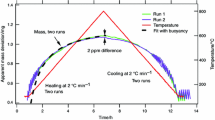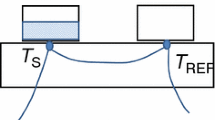Summary
The weighing of hygroscopic solids in milligram procedures is influenced mainly by the relative hygroscopicity of the substance. Three types of hygroscopicity are differentiated according to the moisture adsorption in µg. of a 5 mg. sample. These types are similar to those described byHayman.
Charging tubes with ground caps offer many advantages for the drying as well as for the weighing of solids of medium hygroscopicity (type B), and also partly for those of extremely high hygroscopicity (type C). A metal rack has been designed to serve as tube holder in theAbderhalden drier. Accurate moisture determinations are easily performed, even for compounds of type C.
The transfer of the dried samples to the reaction vessels without too long an exposure to air is described for the nitrogen-Dumas and carbon and hydrogen determinations.
A routine method for the ultimate analysis of hygroscopic solids has been carefully tested. As known from macroanalytical work, an accurate moisture determination is performed with one part of the original sample; another portion, protected from changes in the moisture content, is used for the various elementary analyses. The main advantage is a considerable saving of time and reduction of manipulative work.
The different procedures are illustrated with experiments on hygroscopic substances of biological origin.
Similar content being viewed by others
Literatur
H. K. Alber, Introduction to the use and care of the microchemical balance, with a review of the weighing tools and of the methods of weighing solid and liquid compounds. Mimeographed outline. 53 pages. Copyrighted 1936, Washington, D. C.
D. F. Hayman, Ind. Engin. Chem., Analyt. Ed.4, 256 (1932); ibid.10, 55 (1938); Mikrochemie23, 238 (1937).
R. T. Milner andM. S. Sherman, Ind. Engin. Chem., Analyt. Ed.8, 427 (1936); Mikrochemie21, 142 (1936).
G. L. Miller andV. du Vigneaud, Journ. Biol. Chemistry118, 101 (1937).
E. W. Flosdorf andG. W. Webster, ibid121, 353 (1937).
K. H. Slotta andW. Forster, Ber. Dtsch. chem. Ges.71, 1082 (1938).
H. Lieb andH. G. Krainick, Mikrochemie9, 367 (1931).
F. Pregl [H. Roth], Die quantitative organische Mikroanalyse, 4. Aufl., see p. 96. Berlin 1935.
A. Friedrich andF. Mandl, Mikrochemie22, 14 (1937).
Pyrex glass tends to accumulate electrical charges which lead to erroneous results in microchemical weighing procedures; see e. g.,W. M. Sprerry, Mikrochemie12, 151 (1933).
The metal rack shown in Fig. 2 was obtained fromCarl von Czoernig, Radnor, Pa., and fitted into the improvedAbderhalden vacuum drying apparatus with interchangeable ground joints, purchased from Scientific Glass Apparatus Co., Bloomfield, N. J.
H. K. Alber andJ. Harand, Journ. Franklin Inst.224, 729 (1937); Ind. Engin. Chem., Analyt. Ed.10, 403 (1938). Figure 3 of the latter article shows the complete set-up of the drying apparatus as used in the present investigation.
E. McDonald, Journ. Franklin Inst.225, 121 (1938).
H. K. Alber, Mikrochemie18, 92 (1935).
J. Unterzaucher, Mikrochemie18, 315 (1935).
A detailed report of this work will be published in Journ. Biol. Chem.; see also footnote 11, p. 50.
J. Lindner, Mikro-maßanalytische Bestimmung des Kohlenstoffes und Wasserstoffes mit grundlegender Behandlung der Fehlerquellen in der Elementaranalyse, pp. 367/68. Berlin 1935.
A. A. Benedetti-Pichler, Ztschr. analyt. Chem.61, 305 (1922).
W. R. Kirner, Ind. Engin. Chem., Analyt. Ed.5, 363 (1933); ibid.7, 294 (1935). Some of the results in these papers are calculated on a moisture-free basis, but no definite statement is given in regard to the method used for deriving the results. In general, it seems that even finely powdered coal belongs to type A of relative hygroscopicity, since the first author could weigh samples for carbon and hydrogen determinations in an open boat.
Author information
Authors and Affiliations
Rights and permissions
About this article
Cite this article
Alber, H.K. Hygroscopic substances in microanalysis. Mikrochemie 25, 47–56 (1938). https://doi.org/10.1007/BF02714748
Received:
Published:
Issue Date:
DOI: https://doi.org/10.1007/BF02714748




